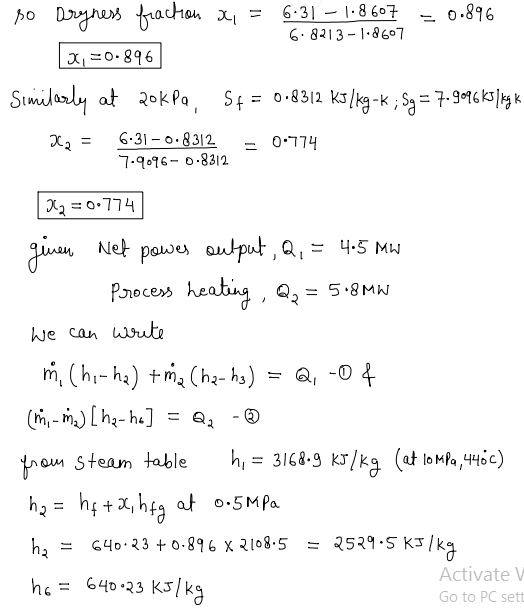Consider a cogeneration plant that uses an ideal Rankine cycle to generate power and steam for process heating, as shown in the figure. The plant provides 4.5 MW of net power output and 5.8 MW of process heating. Steam is supplied to the inlet of the two- stage turbine at 10 MPa and 440°C. A portion of the steam is extracted after exiting the high pressure turbine at 0.5 MPa and is used to meet the process heating load. The steam leaves the process heater as a saturated liquid and mixes with the water leaving the low-pressure pump. Saturated liquid water enters the low-pressure pump at 20 kPa. a. Sketch this cycle on a T-s diagram. b. Determine the mass flow rate of water extracted for process heating, in kg/s. c. Determine the power developed by the turbines, in kw. d. Determine the power input to the pumps, in kW. e. Determine the rate of heat transfer to the water in the steam generator, in kw. f. Determine the net power output of the system, in kW.
Consider a cogeneration plant that uses an ideal Rankine cycle to generate power and steam for process heating, as shown in the figure. The plant provides 4.5 MW of net power output and 5.8 MW of process heating. Steam is supplied to the inlet of the two- stage turbine at 10 MPa and 440°C. A portion of the steam is extracted after exiting the high pressure turbine at 0.5 MPa and is used to meet the process heating load. The steam leaves the process heater as a saturated liquid and mixes with the water leaving the low-pressure pump. Saturated liquid water enters the low-pressure pump at 20 kPa. a. Sketch this cycle on a T-s diagram. b. Determine the mass flow rate of water extracted for process heating, in kg/s. c. Determine the power developed by the turbines, in kw. d. Determine the power input to the pumps, in kW. e. Determine the rate of heat transfer to the water in the steam generator, in kw. f. Determine the net power output of the system, in kW.
Elements Of Electromagnetics
7th Edition
ISBN:9780190698614
Author:Sadiku, Matthew N. O.
Publisher:Sadiku, Matthew N. O.
ChapterMA: Math Assessment
Section: Chapter Questions
Problem 1.1MA
Related questions
Question
Having Trouble with D)-F)
B=3.02 Kg/s
C=4500KW
D- F not to sure about the Pump and the heat transfer

Transcribed Image Text:Consider a cogeneration plant that uses an ideal Rankine cycle to generate power and
steam for process heating, as shown in the figure. The plant provides 4.5 MW of net
power output and 5.8 MW of process heating. Steam is supplied to the inlet of the two-
stage turbine at 10 MPa and 440°C. A portion of the steam is extracted after exiting the
high pressure turbine at 0.5 MPa and is used to meet the process heating load. The
steam leaves the process heater as a saturated liquid and mixes with the water leaving
the low-pressure pump. Saturated liquid water enters the low-pressure pump at
20 kPa.
a. Sketch this cycle on a T-s diagram.
b. Determine the mass flow rate of water extracted for process heating, in kg/s.
c. Determine the power developed by the turbines, in kw.
d. Determine the power input to the pumps, in kW.
e. Determine the rate of heat transfer to the water in the steam generator, in kW.
f. Determine the net power output of the system, in kW.
el-
-Cooling tower
To cooling tower
Condensate
Steam
Condensate
ww
ww
Expert Solution
Step 1




Trending now
This is a popular solution!
Step by step
Solved in 2 steps with 7 images

Knowledge Booster
Learn more about
Need a deep-dive on the concept behind this application? Look no further. Learn more about this topic, mechanical-engineering and related others by exploring similar questions and additional content below.Recommended textbooks for you

Elements Of Electromagnetics
Mechanical Engineering
ISBN:
9780190698614
Author:
Sadiku, Matthew N. O.
Publisher:
Oxford University Press

Mechanics of Materials (10th Edition)
Mechanical Engineering
ISBN:
9780134319650
Author:
Russell C. Hibbeler
Publisher:
PEARSON

Thermodynamics: An Engineering Approach
Mechanical Engineering
ISBN:
9781259822674
Author:
Yunus A. Cengel Dr., Michael A. Boles
Publisher:
McGraw-Hill Education

Elements Of Electromagnetics
Mechanical Engineering
ISBN:
9780190698614
Author:
Sadiku, Matthew N. O.
Publisher:
Oxford University Press

Mechanics of Materials (10th Edition)
Mechanical Engineering
ISBN:
9780134319650
Author:
Russell C. Hibbeler
Publisher:
PEARSON

Thermodynamics: An Engineering Approach
Mechanical Engineering
ISBN:
9781259822674
Author:
Yunus A. Cengel Dr., Michael A. Boles
Publisher:
McGraw-Hill Education

Control Systems Engineering
Mechanical Engineering
ISBN:
9781118170519
Author:
Norman S. Nise
Publisher:
WILEY

Mechanics of Materials (MindTap Course List)
Mechanical Engineering
ISBN:
9781337093347
Author:
Barry J. Goodno, James M. Gere
Publisher:
Cengage Learning

Engineering Mechanics: Statics
Mechanical Engineering
ISBN:
9781118807330
Author:
James L. Meriam, L. G. Kraige, J. N. Bolton
Publisher:
WILEY